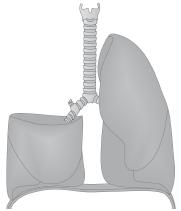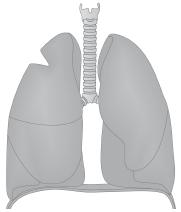INTRODUCTION
Treatment of lung cancer often involves a multidisciplinary team such as cardiothoracic surgeon, oncologists, pathologist, radiologists and other allied health staffs.
The type of treatment given depends on many factors such as cancer stage, age and physical fitness status, patients’ wishes and availability of the desired treatment modality and expertise.
SURGERY
Radical surgery for curative intent is only indicated in non-small cell lung cancer type that is small and has not spread( stage I and 2).
Complete surgical excision of tumour offers the best chance of cure but only around 25% of patients will be suitable candidates for surgery.
Before surgery, you may need a lung function test to assess the functional capacity to cope with the surgery.
Surgery will remove part / the whole lung and lymph nodes in the chest, depending on the size and location of the tumour and the respiratory reserves of the patient.
There are 3 types of surgery for lung cancer:
- Lobectomy
- Phenumonectomy
- Wedge resection/segmentectom
Lobectomy
- Removal of a section of the lung as shown in the diagram below.

Pneumonektomi
- Removal of an entire lung as shown in the diagram below.

Wedge Resection / Segmentektomi
- Remove a small section of lung that contains the tumor as shown in the diagram below.

THERAPY
RADIOTHERAPY
Radiotherapy is treatment of cancer with high energy ionizing radiation. Radiotherapy can be given either as external radiotherapy from outside the body or from within the body as internal radiotherapy.
- External radiotherapy uses radiation that is produced by a machine and directs it towards your cancer. This type of radiotherapy is given after or together with chemotherapy in locally advanced (stage 3A and 3B) lung cancer with the intent for cure. In patients with advanced lung cancer, external radiotherapy can be useful to relieve symptoms or complications from cancer such as:
-
- Local treatment of tumour with the intent to control or palliate symptoms
- Relieve obstructive airway symptoms
- Relieve haemoptysis( bleeding from tumour)
- Reduce chest pain
- Relieve bone pain from bony metastases
- Treatment of spinal cord compression from metastases in the vertebral spine
- Internal radiotherapy or brachytherapy uses a small radioactive wire (Iridium 192) that gets inserted into the lumen of the bronchus next to the tumour. It is often given in a palliative setting, just to control the tumour and not for cure.
- Radiotherapy to lung cancer may cause:
â—¦ Early effects ( during radiotherapy):
-
-
- Anorexia
- Nausea
- Tiredness
- Dry cough
- Heartburn
â—¦ Late effects (long after radiotherapy)
-
-
- Scarring of lung tissue( lung fibrosis)
- Radiation pneumonitis( inflammation of the lungs)
CHEMOTHERAPY
- It is a treatment of lung cancer with anti-cancer drugs (cytotoxics) aimed at destroying cancer cells.
- It can be administered via injection into vein (intravenously), via a chemoport or orally using tablets.
- It can be used in combination with surgery and/or radiotherapy in treatment of lung cancer.
- Your doctor will advise you on the choice of chemotherapy drugs depending on your type and stage of cancer, the type and intent of treatment you are to receive and other factors such as your physical status, other medical conditions and blood profiles.
- Amongst the general side effects of chemotherapy for lung cancer are:
-
- Mouth ulcer or mucositis
- Nausea
- Vomiting
- Diarrhoea
- Hair loss
- Tiredness
- Loss of apetite
- Fever
- Infection
- Bleeding tendencies
TARGETED THERAPY
- This is the newest treatment added to the various therapies available for lung cancer.
- It uses ‘smart drugs’ with cytostatic properties that target cancer cells aimed at controlling its growth and proliferation.
- It is not used for cure but only for control of advanced cancer.
- It is available in tablet and intravenous forms and can be used on its own or in combination with chemotherapy drugs.
- Your doctor will advise you on the choice of agent depending on your type of cancer and other factors.
- Amongst the side effects of targeted therapy for lung cancer are:
-
- Skin rash
- Acne like skin lesions
- Diarrhoea
- Tiredness
- Nausea, vomiting
- Protein in the urine
PALLIATIVE THERAPY
- This is non-definitive treatment aimed at improving patients’ condition and symptoms arising from advanced lung such as treatment with drugs, procedure and counseling therapy. It may involve many health providers from both hospital or community based practices such as palliative care physicians, pain specialists, surgeon, oncologists, psychologists, nurses, nutritionists, physiotherapist or occupational therapist, home nursing or hospice staff and many others. Palliative care physician may also speak to advanced cancer patients or their carer/family members on other important issues such as end of life issues etc.
Updated:: 14/03/2019 []
MEDIA SHARING


























